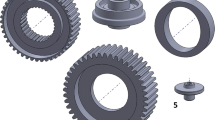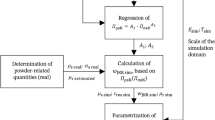Abstract
Powder metallurgy processes are used in many material technologies for manufacturing of a wide range of industrial parts. Products such as components for cars, cemented carbides and high-speed steels for mechanical cutting, magnets and soft magnetic materials, bearings and refractory metals are made from powder. These parts are manufactured by powder die pressing followed by sintering of the resulting green body in a furnace. Traditionally, experience-based methods have been used to design and adapt the processing variables for optimal performance. Cost savings can be made if the tool design can be based on reliable predictive numerical simulations of the powder compaction process. Computer modelling could aid process and design engineers in selecting and optimizing the best pressing route for many industrial components. The aim of the present work has been to develop an efficient way to determine the necessary constitutive model parameters of the numerical models by means of inverse modelling. An experiment for establishing input data to the inverse problem has been designed and validated. The objective function is formed based on the discrepancy in force–displacement data between the numerical model prediction and the experiment. Minimization of the objective function with respect to the material parameters is performed using an in-house optimization software shell which is built on a modified Nelder–Mead simplex method also known as the subplex method. The completed analyses show that the proposed approach can readily be used to determine material parameters.
Similar content being viewed by others
References
ABAQUS/Explicit User's Manual Version 5.8 (1998) Hibbit, Karlsson & Sorensen, Inc., 1080 Main Street, Pawntucket, RI 02860-4847, USA
Bathe KJ (1996) Finite element procedures. Prentice-Hall, New Jersey, USA
Belytschko T (1983) An overview of semidiscretization and time integration procedures. In: Belytschko T, Hughes TJR (eds) Computational methods in transient analysis. Elsevier, Amsterdam, pp 1–65
Benson DJ (1989) An efficient, accurate, simple ALE method for nonlinear finite element programs. Comput Methods Appl Mech Eng 72:305–350
Coube O (1998) Modelling and numerical simulation of powder die compaction with consideration of cracking. Ph.D. thesis, Universit Pierre et Marie Curie, Paris VI, France
DiMaggio FL, Sandler IS (1971) Material models for granular soils. J Eng Mech Div ASCE 96:935–950
Ernst E, Schröder C, Arnold V, Wähling R, Beiss P (1990) Friction measurements during powder compaction. Advances in powder metallurgy, vol. 1. MPIF/APMI, Princeton, NJ, USA, pp 307–321
Kergadallan J, Puente G, Doremus P, Pavier E (1997) Compression of an axisymmetric part with an instrumented press. In: Proceedings of international workshop on modelling of metal powder forming processes, Grenoble, 21–23 July, pp 277–285
Mahnken R, Stein E (1994) The identification of parameters for visco-plastic models via finite element methods and gradient methods. Model Simul Mater Sci Eng 2:597–616
Nelder JA, Mead R (1965) A simplex method for functional minimisation. Comput J 7:308–313
Oldenburg M, Häggblad H-Å (1992) A contact constraint method with friction for explicit analysis applied to powder compaction problems. In: Proceedings of the first European conference on numerical methods in engineering, Brussels, Belgium, 7–11 September
Oldenburg M, Nilsson L (1994) The position code algorithm for contact searching. Int J Numer Methods Eng 37:113–118
Pavier E, Doremus P (1996) Mechanical behaviour of a lubricated iron powder. In: Cadle TM, Narasimhan KS (eds) Advances in powder metallurgy and particulate materials—1996. Metal Powder Industries Federation, Princeton, USA, pp 6-27–6-40
Riera MD, Prado JM (1997) Elastic behaviour of metal powders. In: Proceedings of international workshop on modelling of metal powder forming processes, Grenoble, 21–23 July, pp 29–32
Rowan TH (1990) Functional stability analysis of numerical algorithms. Ph.D. thesis, The University of Texas at Austin, USA
Sandler IS, Rubin D (1979) An algorithm and a modular subroutine for the cap model. Int J Numer Anal Methods Geomech 3:173–186
Simo JC, Ju J-W, Pister KS, Taylor RL (1988) Assessment of cap model: consistent return algorithm and rate-dependent extensions. J Eng Mech 114
Solimannezhad N, Larsson R (1999) Dependence of friction on various parameters in the metal powder compaction process. In: Proceedings of PM2TEC advances in powder metallurgy and particulate materials, Vancouver, Canada, Part 2, pp 33–44
Whirley RG, Engelmann BE, Hallquist JO (1992) DYNA2D—a nonlinear, explicit, two-dimensional finite element code for solid mechanics—user manual. UCRL-MA-110630, Lawrence Livermore National Laboratory, USA
Wikman B, Bergman G (2000) INVSYS—an inverse modelling system—user manual. Technical Report, 2000:27. Lule University of Technology, Sweden
Wikman B, Solimannezhad N, Larsson R, Oldenburg M, Häggblad H-Å (2000) Wall friction coefficient estimation by modelling of a powder die pressing experiment. Powder Metall 43(2):132–138
Author information
Authors and Affiliations
Corresponding author
Rights and permissions
About this article
Cite this article
Wikman, B., Bergman, G., Oldenburg, M. et al. Estimation of constitutive parameters for powder pressing by inverse modelling. Struct Multidisc Optim 31, 400–409 (2006). https://doi.org/10.1007/s00158-005-0556-7
Received:
Revised:
Published:
Issue Date:
DOI: https://doi.org/10.1007/s00158-005-0556-7




